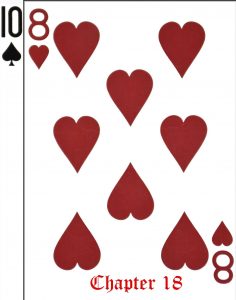Pre-emptive bids are made at the three-level or higher. They show hands that are weak but long, with at least a seven-card suit. They are best made as an opening bid, or for the player third in hand. By the same token you would rarely overcall with a pre-emptive bid (second in hand) and rarer still if in fourth position. With a weak hand in second position it would be better to pass, and then, if the opportunity presents itself to make your first bit second time round.
They show hands that are weak but long, with at least a seven-card suit. They are best made as an opening bid, or for the player third in hand. By the same token you would rarely overcall with a pre-emptive bid (second in hand) and rarer still if in fourth position. With a weak hand in second position it would be better to pass, and then, if the opportunity presents itself to make your first bit second time round.
Do not pre-empt if you have a four-card major as a second suit.
You can start off using the standard Milton Work count to get an idea of the strength of your hand. But in practice advanced players tend to use Playing Tricks to value both for the Strong Two opening bids and for pre-emptive bids. When responding to a pre-emptive bid use the Quick Trick count.
It is pretty easy to spot a hand suitable for a pre-emptive bid. First, look out for a 7- or 8-carder. Then bid 3 of a suit for a weak hand (6-10 points), and 4 of a suit for a strong hand (11+ points).
The three no trump pre-emptive has nothing to do with a balanced hand, but shows a long solid minor that is low on points, say, no more than 10. By the same token the 4NT pre-emptive is also an unbalanced, but very strong hand or 14+ points, even as high as the 23-24 point range. The 5-suit opener is roughly the same as the 3NT hand but with a very long suit, and eight or nine carder.
Summary for pre-emptive opener
It is very important to bear in mind that any pre-emptive bid is strongly based on distribution, which is why the high card point count is less favoured and why Playing Tricks are more helpful in valuing your hand. There are additional factors to consider, not least of all, vulnerability, whether partner has already bid or not, and whether the opposition has spoken. The following table is a rough guide.
| Summary for opening at the three or more level | ||
|---|---|---|
| Points | Holding | Opening bid |
| 6-10 | 6 playing tricks* | 3 of a suit |
| 10-13 | Long solid minor - unbalanced | 3NT |
| 11 | With 8 playing tricks | 4 of a suit |
| 12-13 | 8-carder | 4 of a suit |
| 14+ | 7-carder | 4 of a suit |
| 14+ | Very strong hand - unbalanced | 4NT |
| 12+ | 9-carder and eight playing tricks | 5-suit minor |
| 16+ | Solid hand less both top honours | 5-suit major |
| *if vulnerable make that 7 playing tricks | ||
Playing tricks
Playing tricks, you will remember, were covered in Chapter Fifteen with reference to Strong Two opening bids. And, as we have said, they are also favoured for valuing the pre-emptive hand.
| Playing tricks table | |
|---|---|
| In the top three of the long suit count: A = 1, K = 1, Q= ½ , and J = ½ | |
| In the long suit for the cards below the top three count 1 each | |
| In the side suits count: A = 1, A-K = 2, A-Q = 1½ , K-Q-x = 1½, K-Q = 1, K = ½ , and Q-J-x = ½ | |
| For a 4th card in a side suit add another ½ , and for a 5th card add another 1 | |
| Examples: | |
| A 7-carder headed by A-K-Q | 7 playing tricks |
| A 7-carder headed by A-K-x | 6 playing tricks |
| An 8-carder headed by A Q J | 7½ playing tricks |
| An outside ace, for example, will add another playing trick to your armoury | |
Back to Top
To continue reading go to: The 3-suit opener
Further pages in this chapter are:
The 3 no trump opener
The 4 suit opener
The 5 suit opener
Defence to pre-emptive bids
By Nigel Benetton – based on the UK Acol Bridge Bidding System
Last updated: Friday, 2nd July 2021